--24t and 535 2 CV. Citroën (1952-63)
It is hard to believe that there are no prior postings, so I will contribute what I can about this vintage French Dinky Model. The Dinky Toys Citroen 2CV was modeled after a well-loved car, made for many years in France. The Dinky model was introduced in 1952, and lasted untll 1963....a lengthy run for an automobile! The basic model changed little over that time, and originally appeared numbered 24T, which was changed to the new French numbering system in 1959 to 535. I have two Dinky models, both purchased back in the late 1950's from H.Hudson Dobson, and fortunately, both have survived all that time in quite good condition. My first one is actually the second type, and was made from 1953 to about 1957, and what distinguishes it from later versions are two items: (1). The rear of the car only shows one taillight, located in the middle, above the rear bumper. (2). It also has the smooth ceiling inside the car....later versions had the familiar checkered pattern cast into the ceiling. The color is grey, with a dark grey, matt finished roof, and cream wheels. My second model is the later version, which now includes a total of 3 taillights....the original one in the center, plus another on both the right and left side. And it now also features the checkered ceiling. My earlier version did not come with a box, so I believe they only came in trade boxes early on. My second one does have its own box, but shows only one color, and not the dark red that mine is. Below are some photos of the models, as well as some catalog images.
Best regards, Terry
A very nice and accurate little model. The only thing that has always annoyed me - and somehow spoilt everything good on the model - are the for over 50% hidden rear wheels, whereas in reality over 50% of them were visible, this vehicle standing so characteristically high on its rear wheels (unless it was overloaded, which admittedly very often happened). Still, Terry, you have some wonderful examples of this model. Kind regards, Jan
Four pictures below of a very nice grey 2CV. Citroën with cream convex hubs, three rear lights, glossy base plate and a renumbered box 535. Its year of production must therefore be close to 1959. The French catalogue picture of that year included, showing both the old 24T and new 535 numbers.
It is remarkable that - whereas the model stands far too low on its rear wheels - the drawn box illustration shows the correct position.
Dear Jan,
An other very nice model in your collection. It was made between 1960 and 63. The overloaded position of the body is certainly intentionnal so that the rear axle did not have to be riveted. This was the case on the early single red lights models in 1952 but there must have been many claims for the rear wheels getting loose, and from 1953 on, the rear axle was domed.
One type of grey trade box is known as well as three types of yellow boxes :
24t
24t - 535
535
A 1st version 24t in the more scarce colour Gris Métallisé doré (Golden metallic grey) I acquired in France. It is the 2nd variant with one rear light, inside smooth roof and rear axle ends domed. The very nice pictures of my model are from the seller. I am very happy with this marvellous addition to my French collection.
The Citroën 2CV has become a French icon. I get excited when I see one driving.
It’s a very simple car that has a certain appeal due to its special shape and properties. It is immediately recognizable by the characteristic sound of the air-cooled engine. Personally, I admire its smooth suspension, of which I will show a drawing with explanation. There are still thousands of them on the road and it is also very popular with young people. In the Netherlands there are still approximately 8500 2CVs operational.
I like to include some interesting details about the development of this French car in my contribution, because I think it’s worth knowing for any collector of this model.
The TPV:
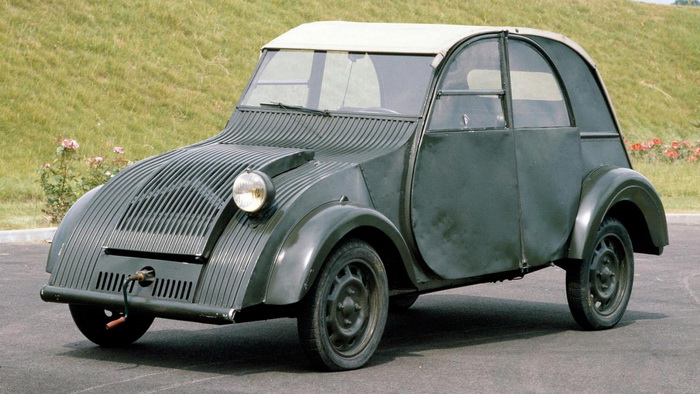
1939 Prototype Citroën 2CV
Source retromotor.co.uk:
The Citroën 2CV was born, not in 1948, but in 1936, as the TPV, or Toute Petite Voiture (Very Small Car). Andre Citroën, the firm’s brilliant innovator and founder, had passed away a year earlier, with the company now under the control of Michelin and still reeling from the effects of bankruptcy. Pierre-Jules Boulanger was the architect-turned-engineer behind the project, who briefed Andre Lefebvre and Flaminio Bertoni on his requirements for a new car.
“Build me an umbrella with four wheels,” he said, in a brief that hints at the car’s simplicity, if not Boulanger’s exacting standards. This was to be a car for people with no experience of machinery, mobilising the rural communities of France like never before. Seats for two peasants and space for 50kg of potatoes or a small cask of wine was central to the requirement, along with an ability to travel across a ploughed field without breaking the eggs being carried in the car. Brilliantly, Boulanger rejected any design proposals if he was unable to sit in the car without removing his hat.
Originally, only one headlight was installed for reasons of economy. However, after a prototype was hit during a test drive, because the oncoming car thought it was a motorcycle, the model was equipped with two headlights.
A car was developed that met most of those requirements, but it was certainly not ready for production. Citroën planned to present a prototype of the car at the Salon de l'Automobile in October 1939, but this Salon was canceled due to the Second World War. The prototypes were destroyed or hidden from the Nazis. Some, mainly prototypes, are hidden in La Ferté-Vidame in the attics of the test center, or in the cellars of the Citroën design office, rue du Théâtre 4. Three prototypes, carefully hidden in an attic of the test center, were recovered in 1995.
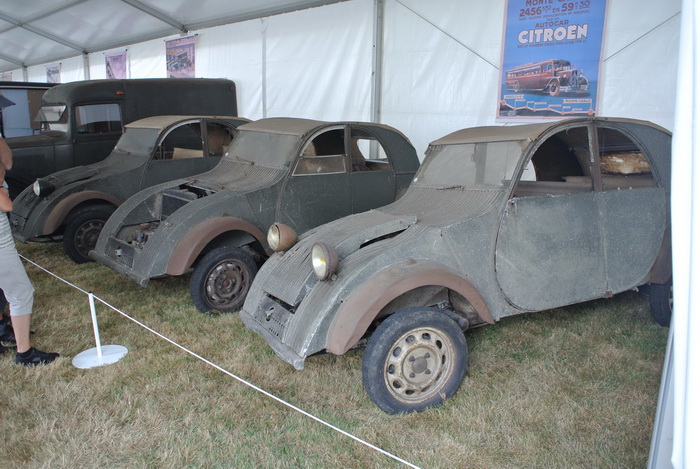
The three TPVs found in the 1990s and presented at the centenary meeting in July 2019 at La Ferté Vidame.
After the war, and after major changes to the original design, the car was presented to the press and public on Thursday 7 October 1948 at the Paris Motor Show.
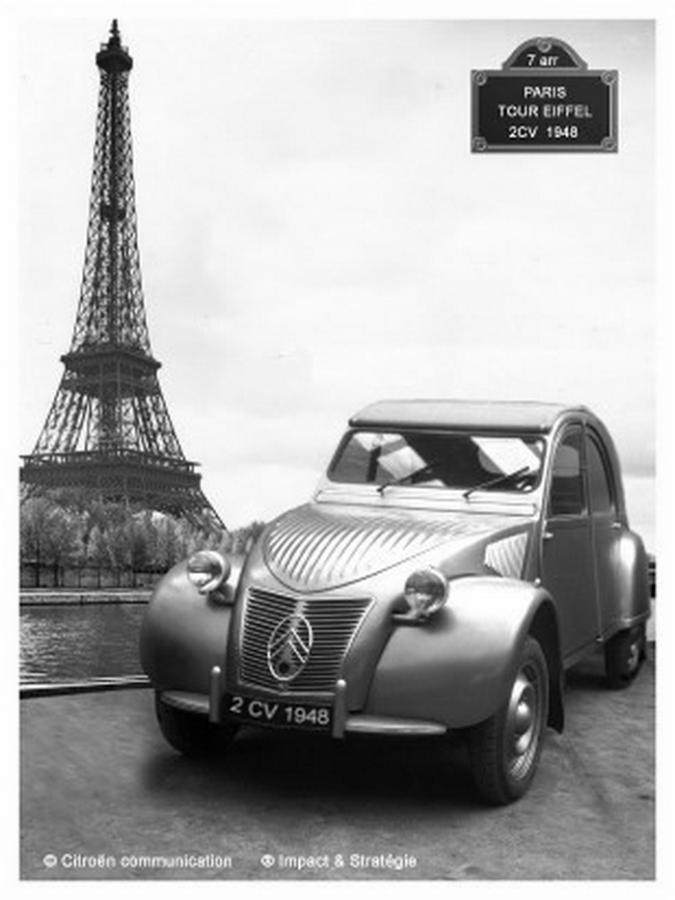
Publication Citroën 2CV 1948 in Paris.
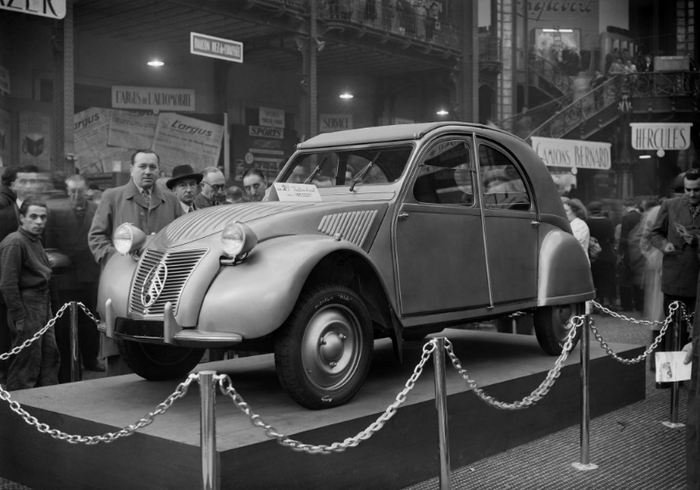
The first exhibition of a 2CV Citroën (with the characteristic ripple bonnet) during the Paris Motor Show in the Grand Palais, October 1948. Photo by AFP.
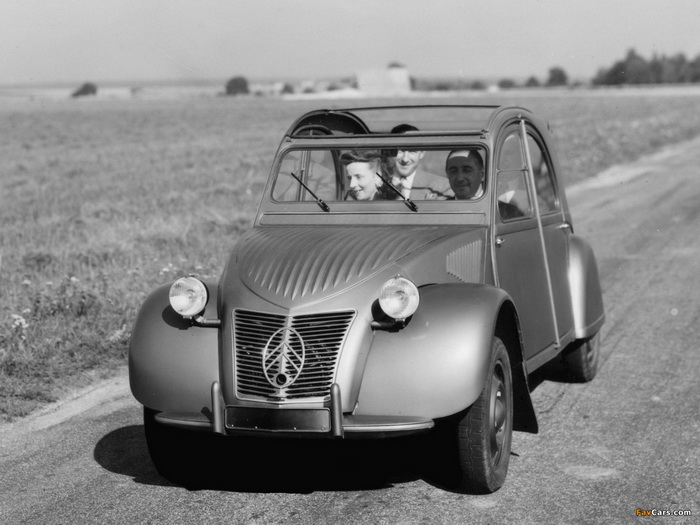
1949 Citroën 2CV with open roof in the countryside of France.
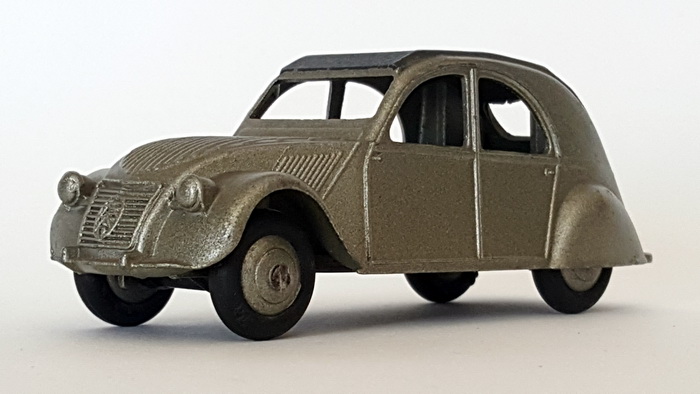
My Dinky Toys 24t Citroën 2 CV golden metallic grey with the characteristic ripple bonnet.
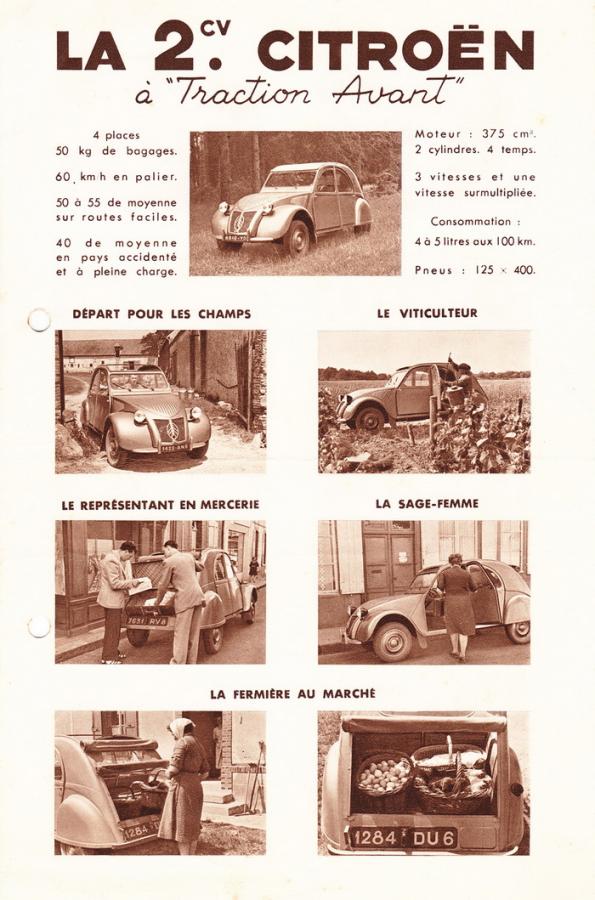
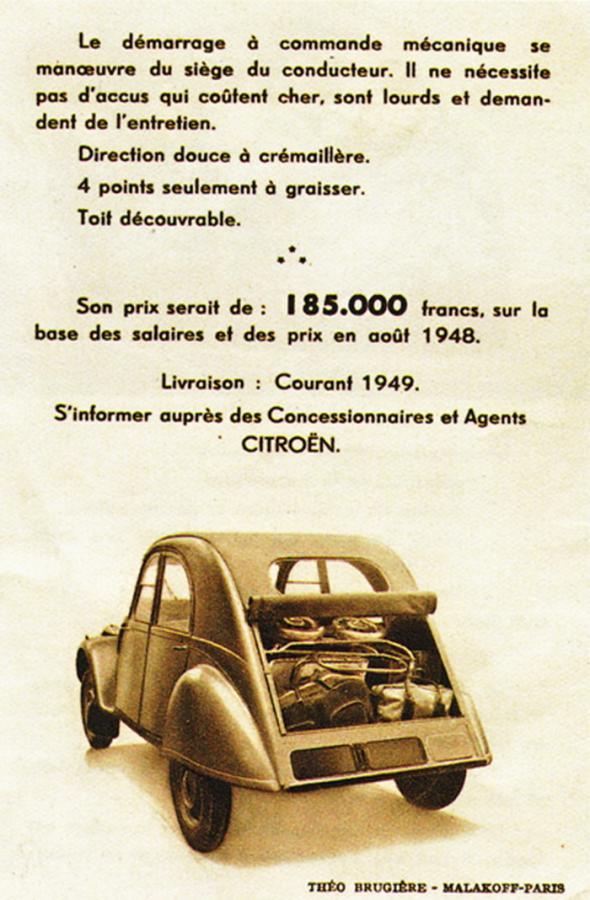
1949 brochure Citroën 2CV in sepia. As simple as the car itself.
Highlights from English Wikipedia:
The Citroën 2CV (French: deux chevaux(-vapeur), lit. "two steam horse(power)s", meaning "two taxable horsepower") is an air-cooled front-engine, front-wheel-drive, economy family car, introduced at the 1948 Paris Mondial de l’Automobile, and manufactured by Citroën for model years 1948–1990.
Often called "an umbrella on wheels", the fixed-profile convertible bodywork featured a full-width, canvas, roll-back sunroof, which accommodated oversized loads, and until 1955 even stretched to cover the car's trunk, reaching almost down to the car's rear bumper.
Between 1948 and 1990, more than 3.8 million 2CVs were produced, making it the world's first front-wheel drive car to become a million seller, after Citroën's own, more upscale Traction Avant was the first front-wheel drive car to sell in six-figure numbers.
One innovation included from the beginning of production was Michelin’s new radial tyre, first commercialised with the introduction of the 2CV. This radial design is an integral part of the design of the 2CV chassis.
Citroën unveiled the car at the Paris Salon on 7 October 1948. The car on display was nearly identical to the 2CV type A that would be sold the next year, but it lacked an electric starter, the addition of which was decided the day before the opening of the Salon, replacing the pull cord starter. The canvas roof could be rolled completely open. The Type A had one stop light, and was only available in grey. The fuel level was checked with a dipstick/measuring rod, and the speedometer was attached to the windscreen pillar. The only other instrument was an ammeter. A special feature of the 2CV is also the position of the gear lever. This extends horizontally through the dashboard. Later, this was also seen in the Renault 4.
1949
In 1949 the first delivered 2CV type A was 375 cc, 9 hp (6.7 kW), with a 65 km/h (40 mph) top speed, only one tail light and windscreen wiper with speed shaft drive; the wiper speed was dependent on the driving speed.
Despite critics, Citroën was flooded with customer orders at the show. The car had a great impact on the lives of the low-income segment of the population in France. The 2CV was a commercial success: within months of it going on sale, there was a three-year waiting list, which soon increased to five years. At the time a second-hand 2CV was more expensive than a new one because the buyer did not have to wait. Production was increased from 876 units in 1949 to 6,196 units in 1950.
1960
In 1960 the production of the 375 cc engine ended. In the front fenders rectangular turn signals were integrated on some export models. The corrugated metal bonnet was replaced by a five-rib glossy cover. Simultaneously, the grille was slightly modified (flatter shape with a curved top edge).
North America
Only a few 2CVs were sold in North America when they were new; similar to the situation in Britain, their pricing was excessive relative to competitors. The original model that produced 9 hp (6.7 kW) and had a top speed of 64 km/h (40 mph) was unsuited to the expanding post-war US freeway network, and was never widely accepted in North America. Even the fastest of the later models struggled to 115 km/h (71 mph).
The 2CV and all its variants are collectively known as the A-Series.
Series production of the 2CV ran from July 11, 1949 to July 27, 1990. In that period, 5,144,966 were built, of which 3,898,631 2CV's and 1,246,335 2CV vans; this number rises to almost 9 million when the sister models Dyane, Ami, Méhari and FAF are included. The appearance of the 2CV, like that of the Citroën ID/DS and the Traction Avant, was designed by Flaminio Bertoni.
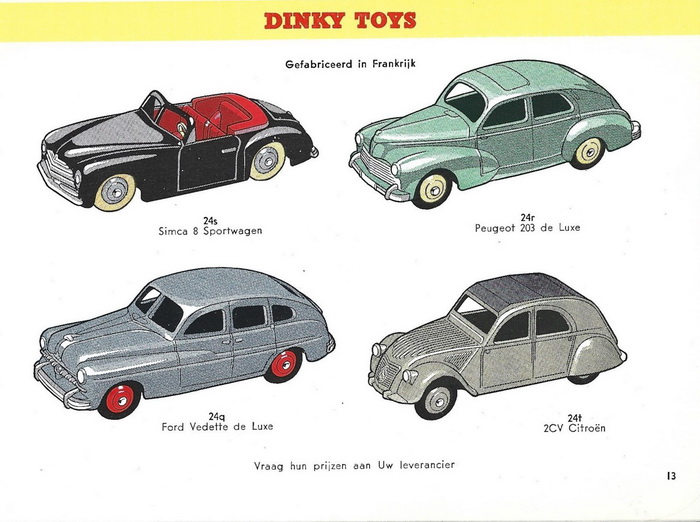
Dinky Toys 24t in Metallic grey in Dutch catalogue 1953. Note also the very nice metallic 24r and 24q.
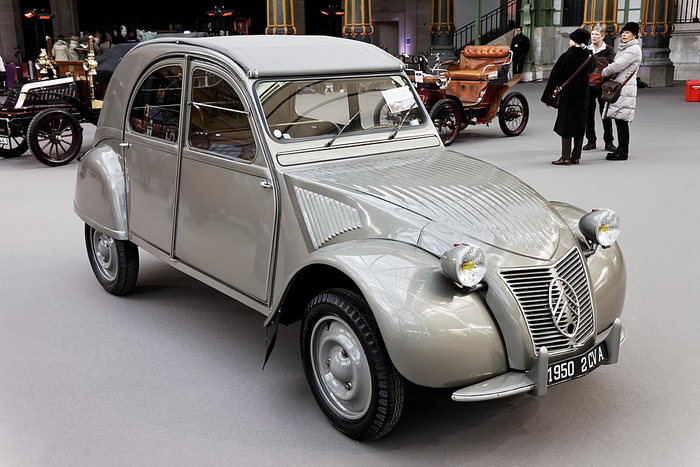
1950 - First generation “ripple bonnet” Citroën 2CV A built from 1949 (Paris Bonhams 2013 Citroën 2CV A 1950)
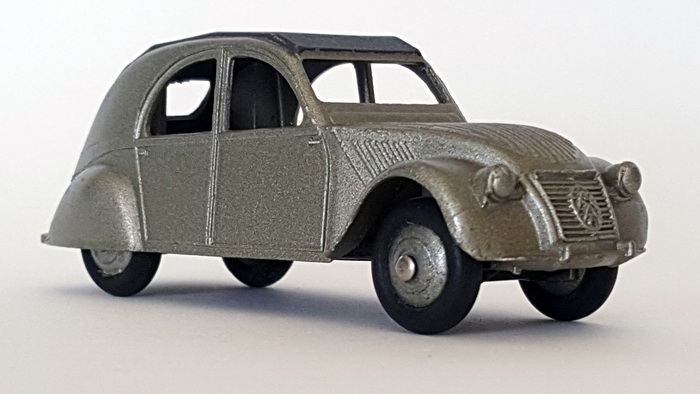
My 1st version Dinky Toys 24t Citroën 2 CV golden metallic grey.
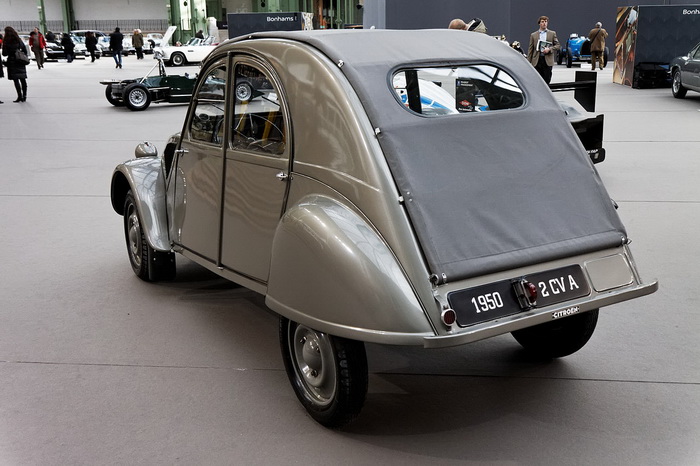
1950 - Citroën 2CV A sedan has canvas trunk, as well as canvas roof – an early example with one rear light!
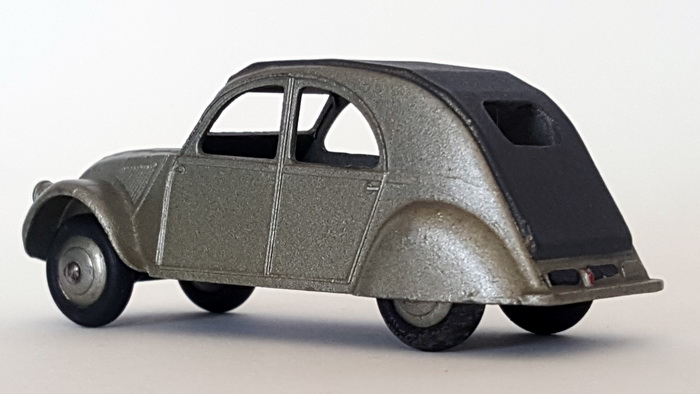
My 24t Citroën 2CV with one rear light.
If you want to know a little more technically about the development of the Citroën 2CV, then you really have to take attention to the functioning of the suspension, described below.
Front to rear interconnected suspension:
The great advantage of this is that the front wheel movement is transferred to the rear wheel – an upward movement as the front wheel encounters a bump results in the rear wheel being provided with more travel and the result is a very smooth ride. The specifics of this system (a single, horizontally mounted coil spring) was not adopted by any other manufacturer but the front to rear interconnection concept was adopted by BMC (later BLMC and then BL) in their range of Hydrolastic/Hydragas sprung cars.
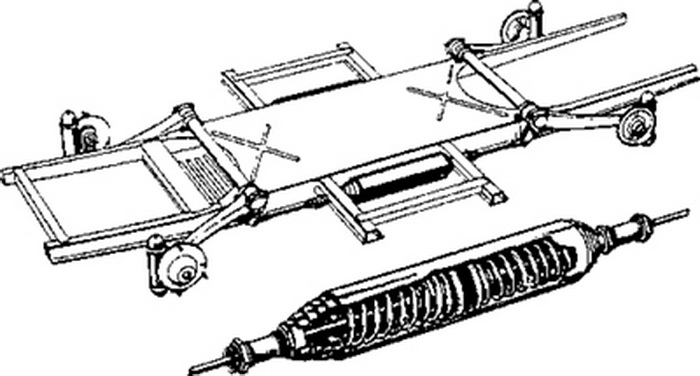
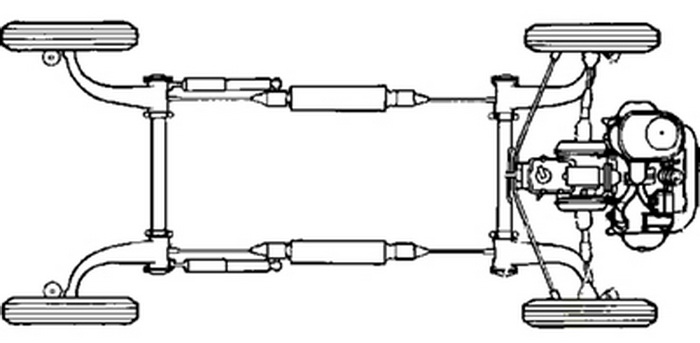
Drawing suspension Citroën 2CV
This suspension design ensured the road wheels followed ground contours underneath them closely, while insulating the vehicle from shocks, enabling the 2CV to be driven over a ploughed field without breaking any eggs, as its design brief required. More importantly it could comfortably and safely drive at reasonable speed, along the ill-maintained and war-damaged post-war French Routes Nationales. It was commonly driven "Pied au Plancher"—"foot to the floor" by their peasant owners. (Wikipedia)

Citroën 2CV cutaway drawing. Note the front to rear interconnected suspension.
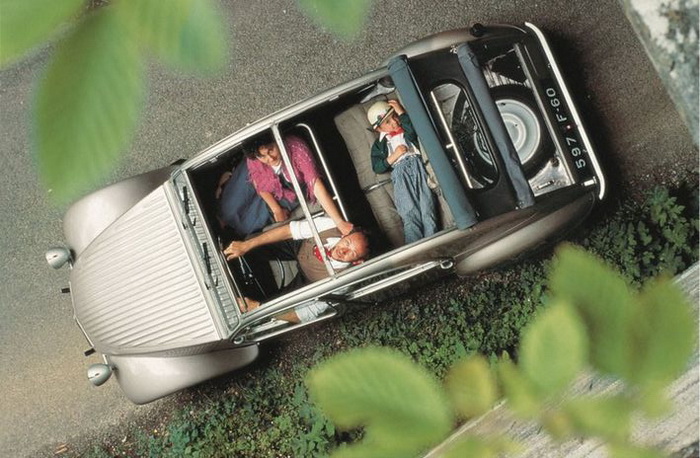
1949/50 Citroën 2CV with open roof top view.
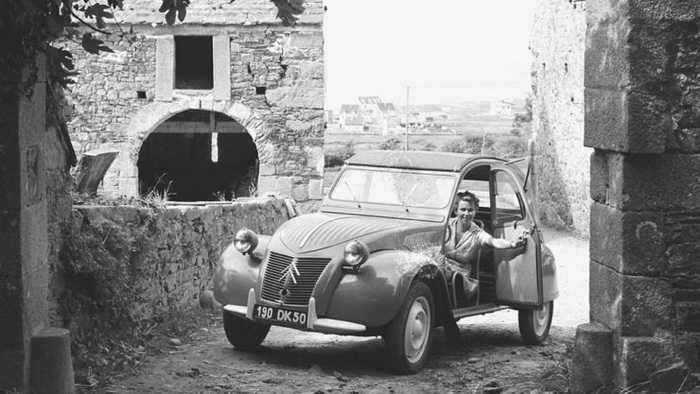
Voilà. The result of a technical masterpiece in simplicity.
Apart from several colour variations there are 2 main casting versions with 5 casting variants:
1st version: with one rear lamp:
Variant 1a: smooth inside roof, rear axle ends not domed, convex hubs
Variant 1b: as above but with rear axle ends from now on domed
Variant 1c: as above but inside roof is from now on checkered
2nd version: with 3 rear lamps (model 1955)
Variant 2a: convex hubs
Variant 2b: concave hubs
24t was always sold in a trade box of six as can be seen in the photo of the collection Gérard Dulin below.
The rear too low of the 24t discussed in contributions #2 and #5 has been corrected in its successor 558 (model 1961) as shown in the photos below.
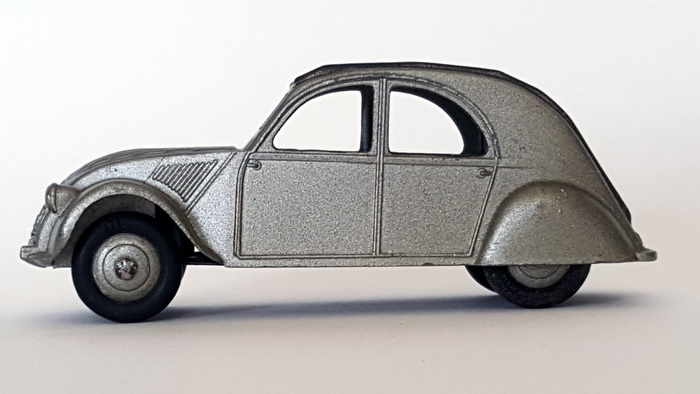
24t with too low rear.
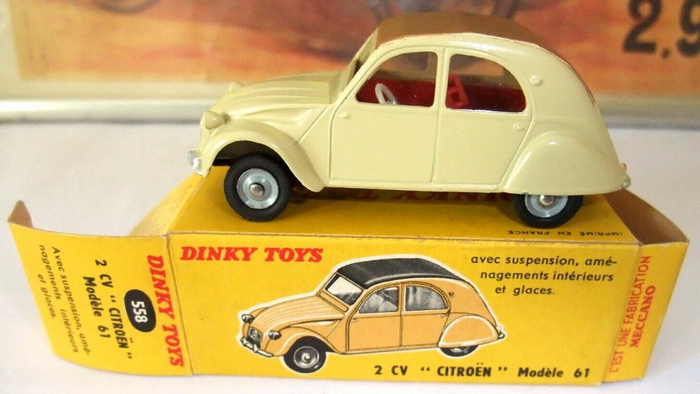
Dinky Toys 558 Citroen 2CV model 1961 with the normal height of the rear.
Meccano Bobigny has reproduced the Citroën 2CV in all kinds of models and appeared in the French DT catalogues until the end of the factory, so it must have been a bestseller.
Jan Oldenhuis 24 October 2022
Ahhhh ben ouai ! alors c'est un code 3.
Ahhhh ! yeahhh then its a code 3.
No Jan. My blue is darker. Colour reference : RAL 5001
Kind regards
Richard
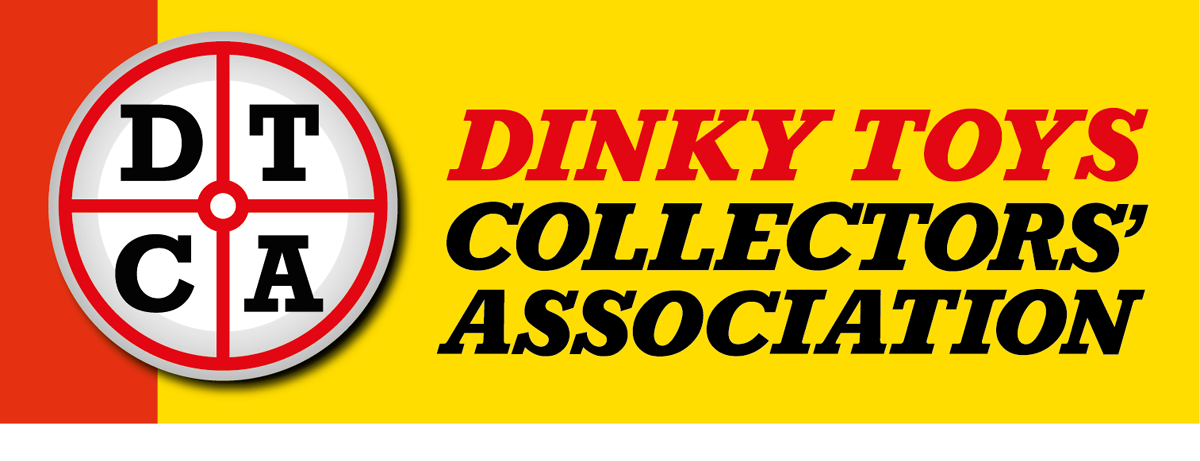


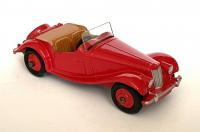
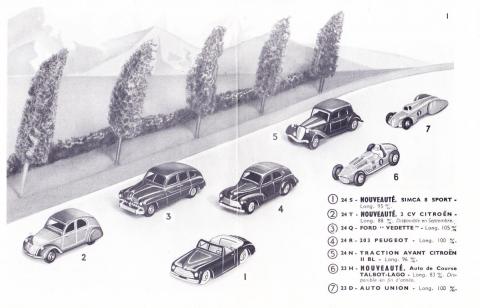

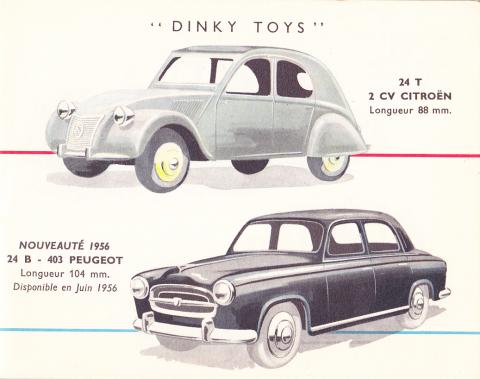

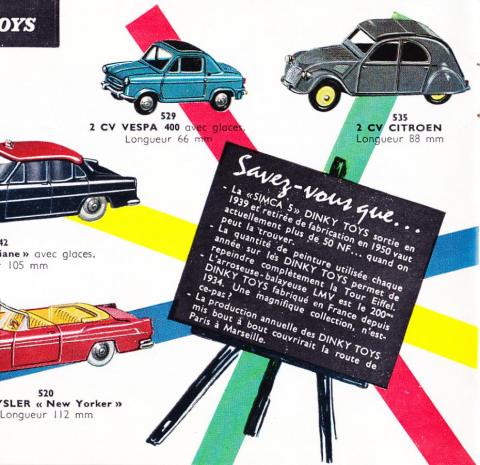

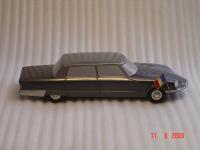
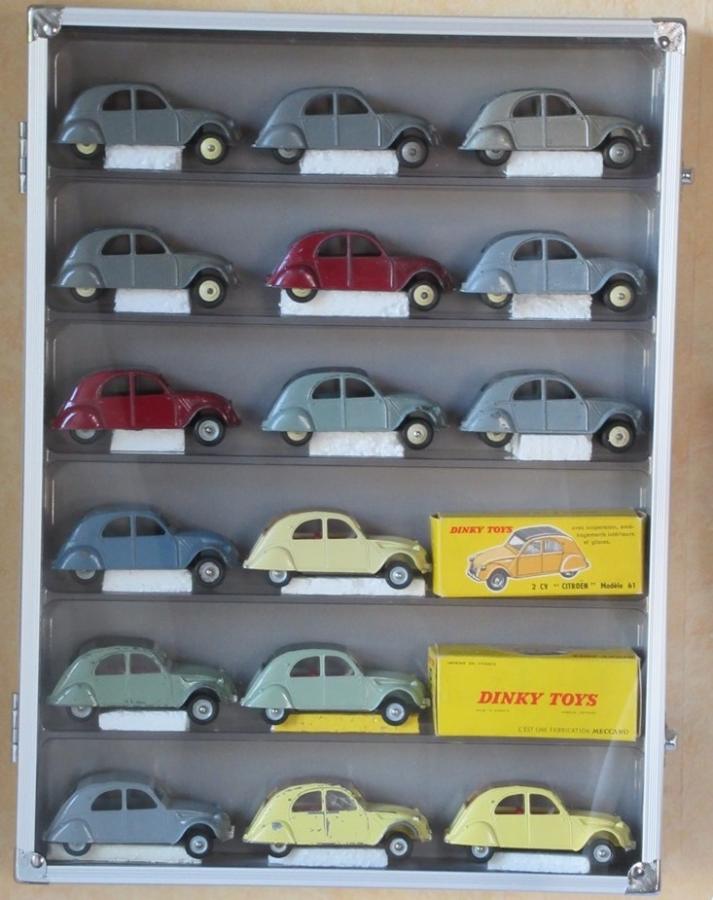
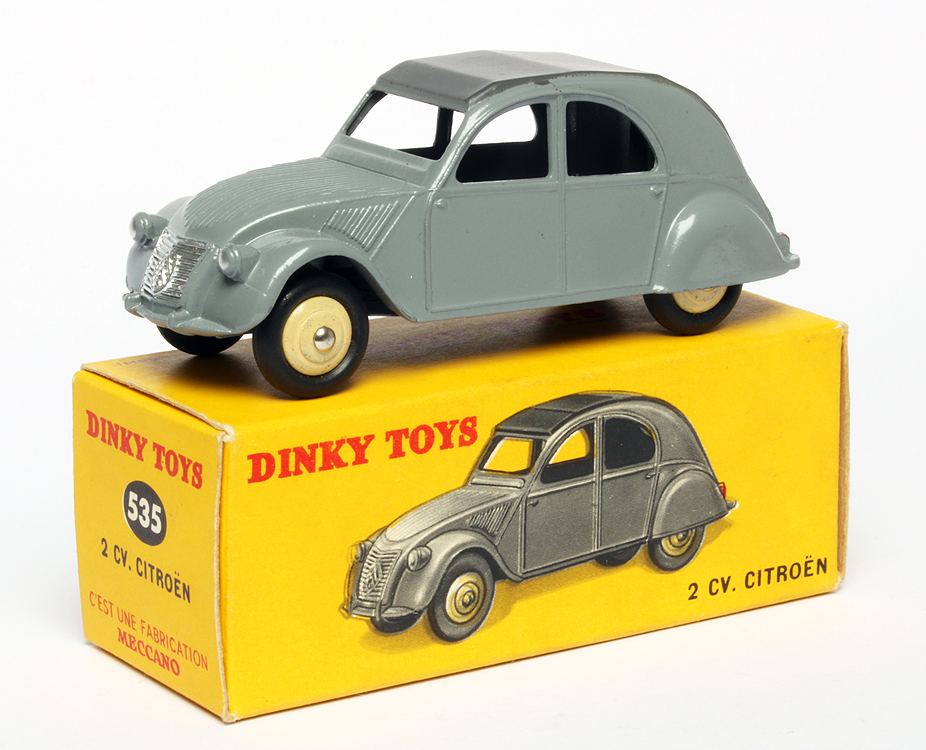
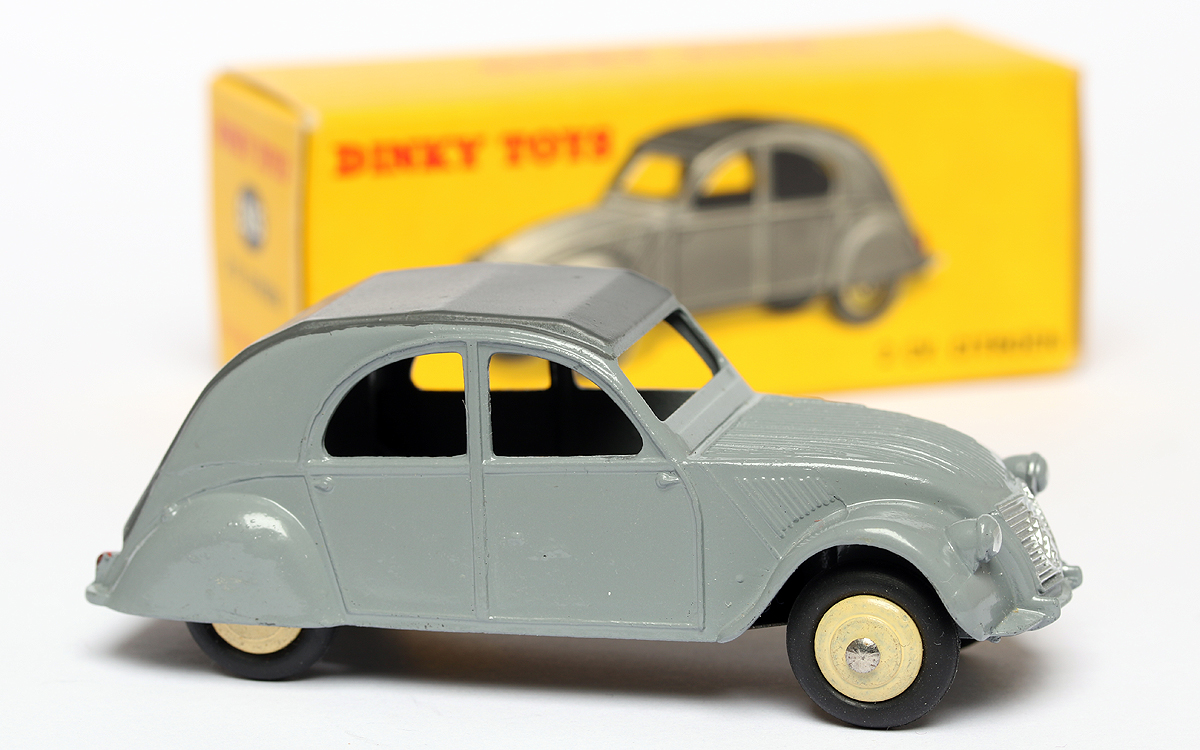
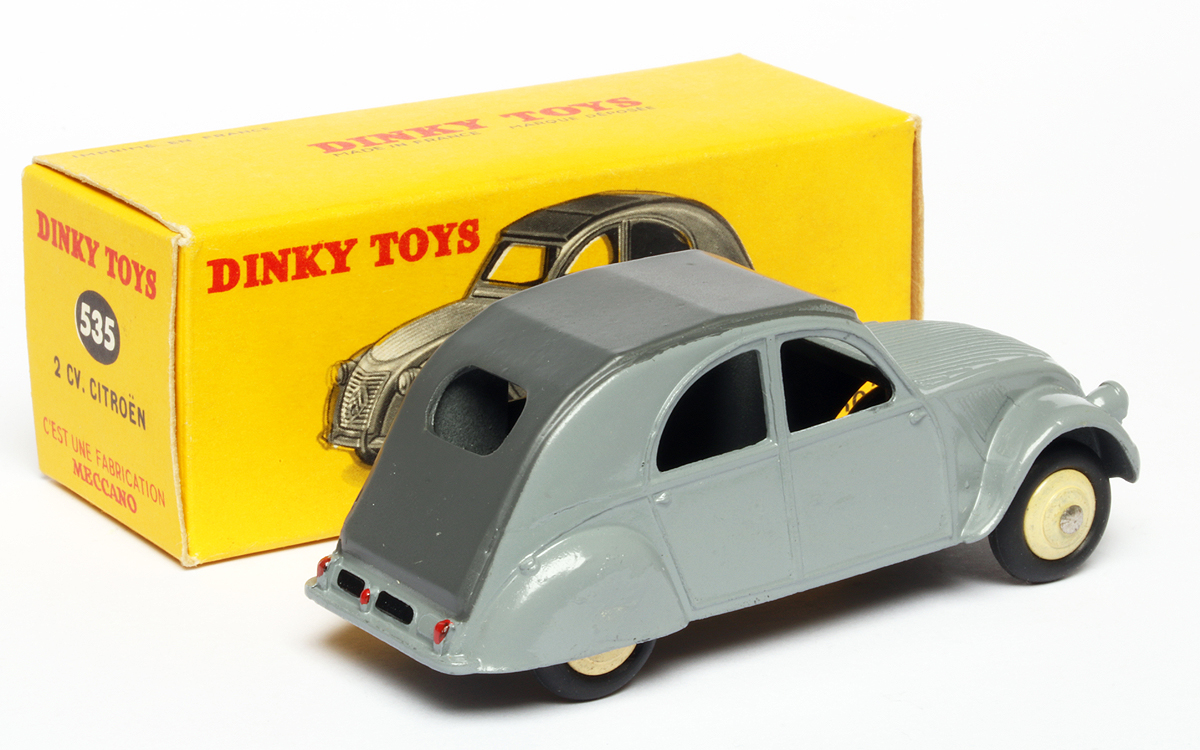
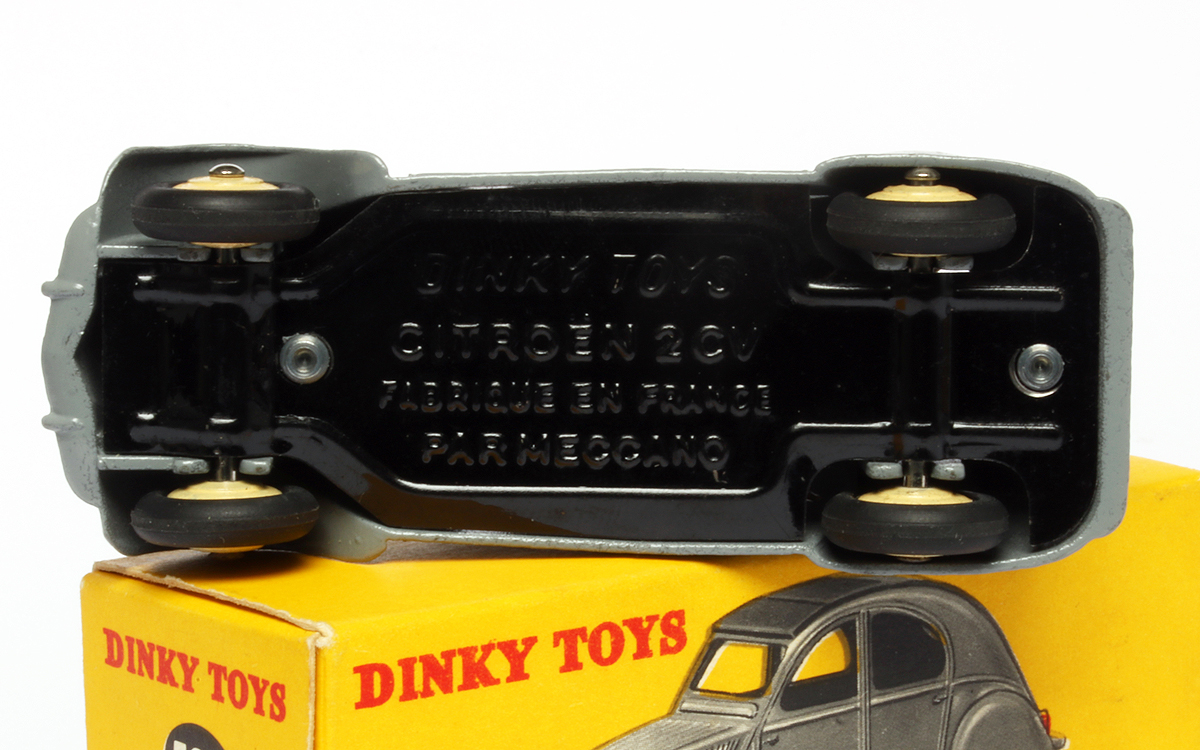
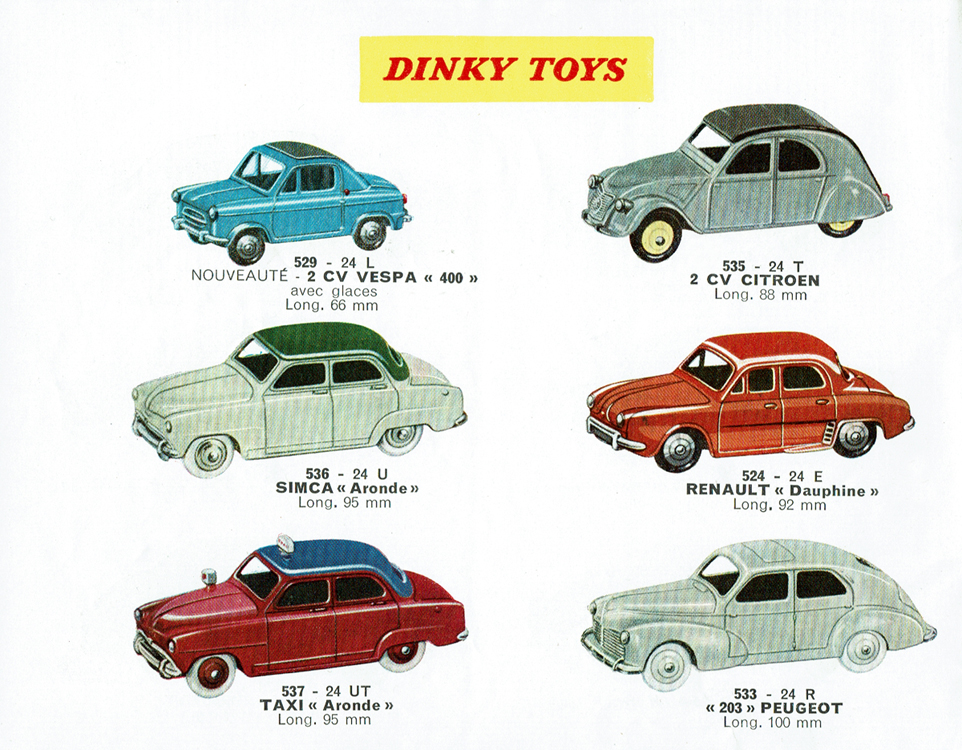


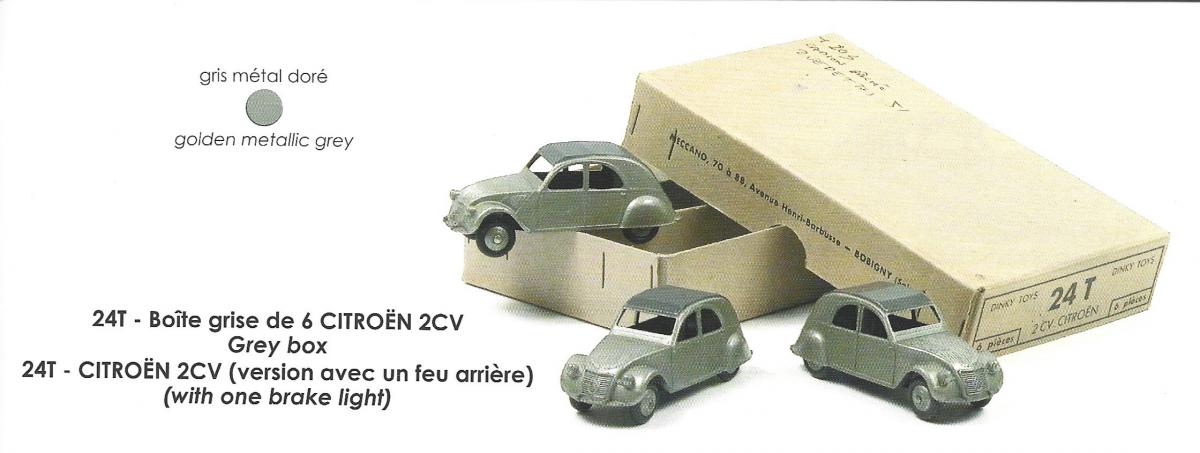
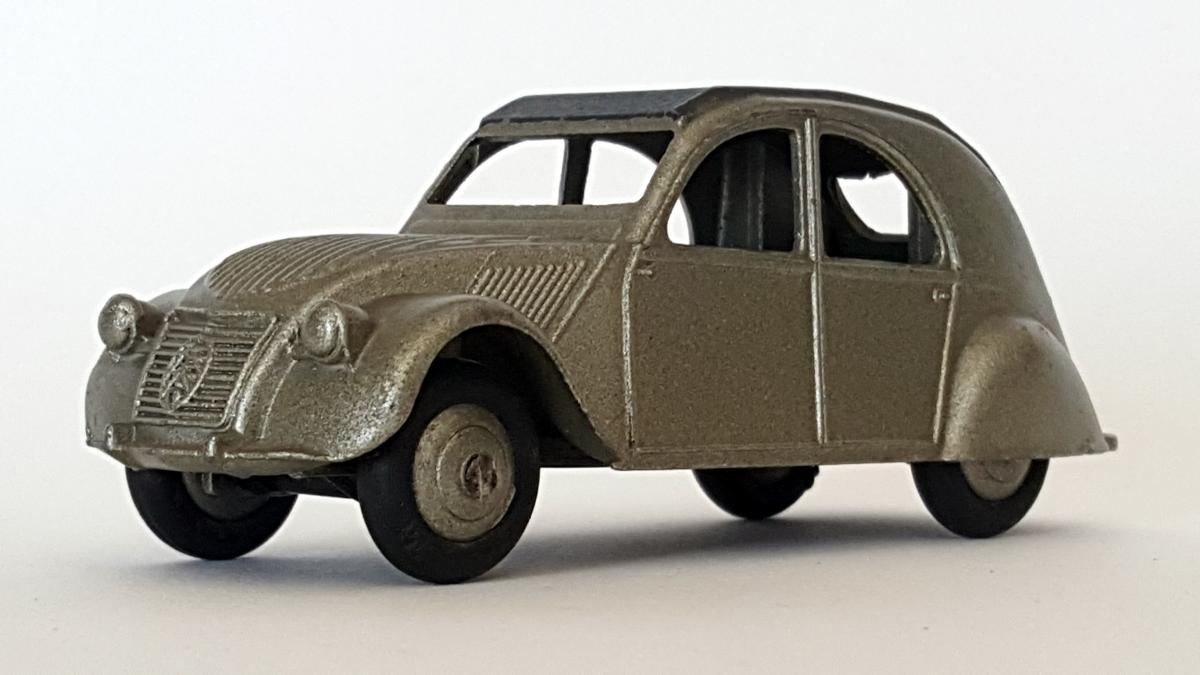
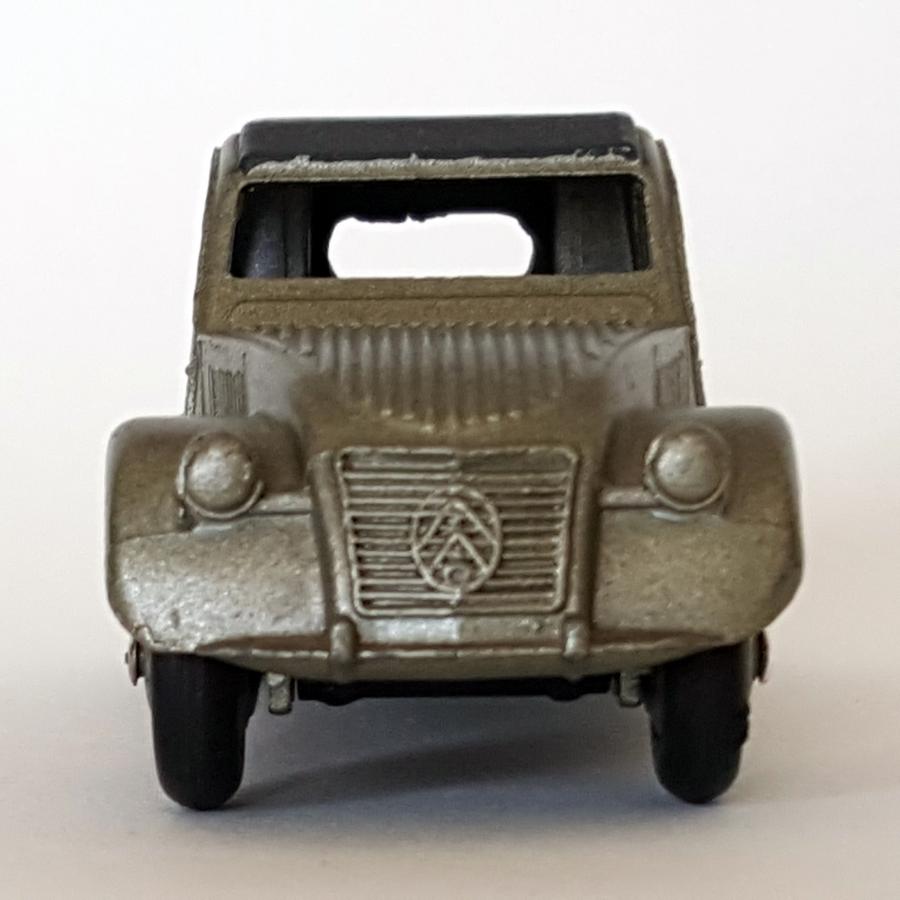
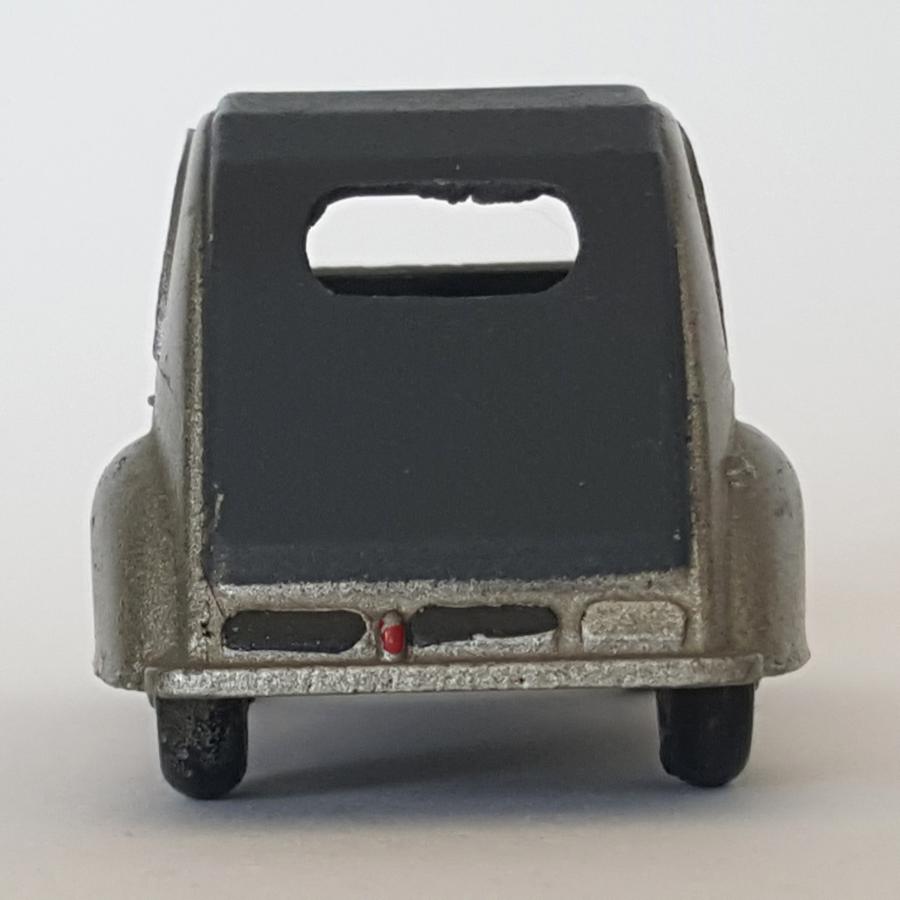
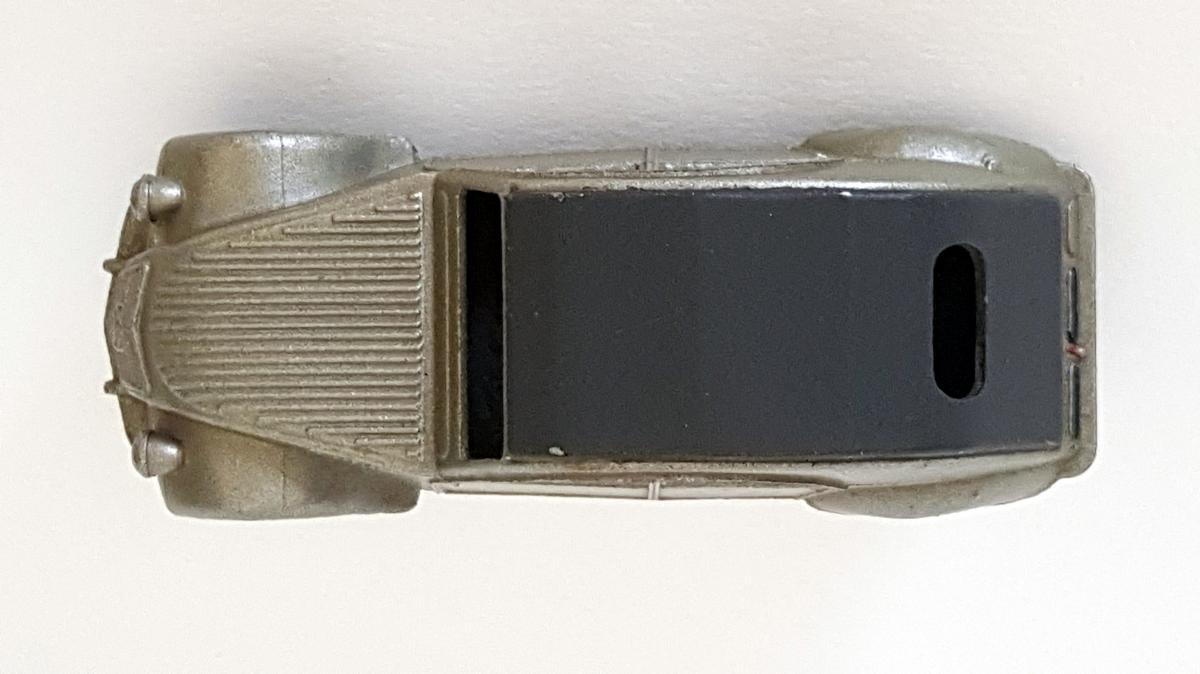
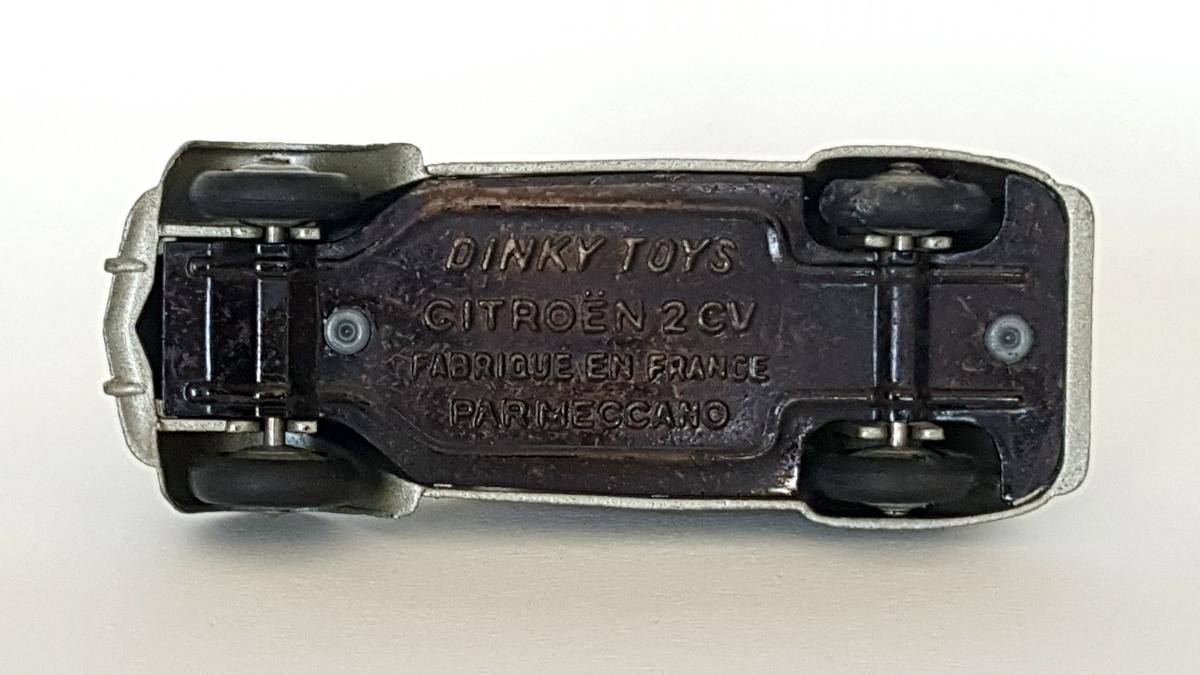
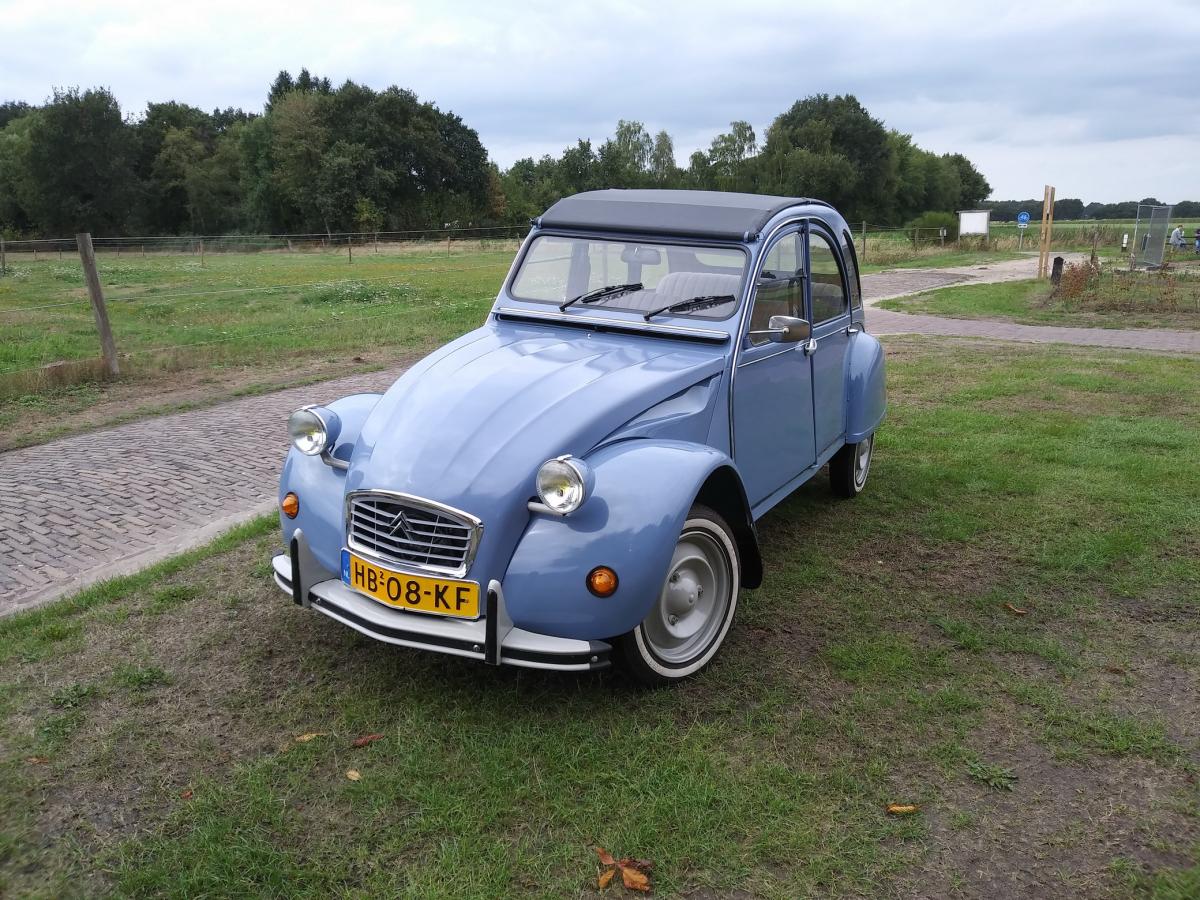
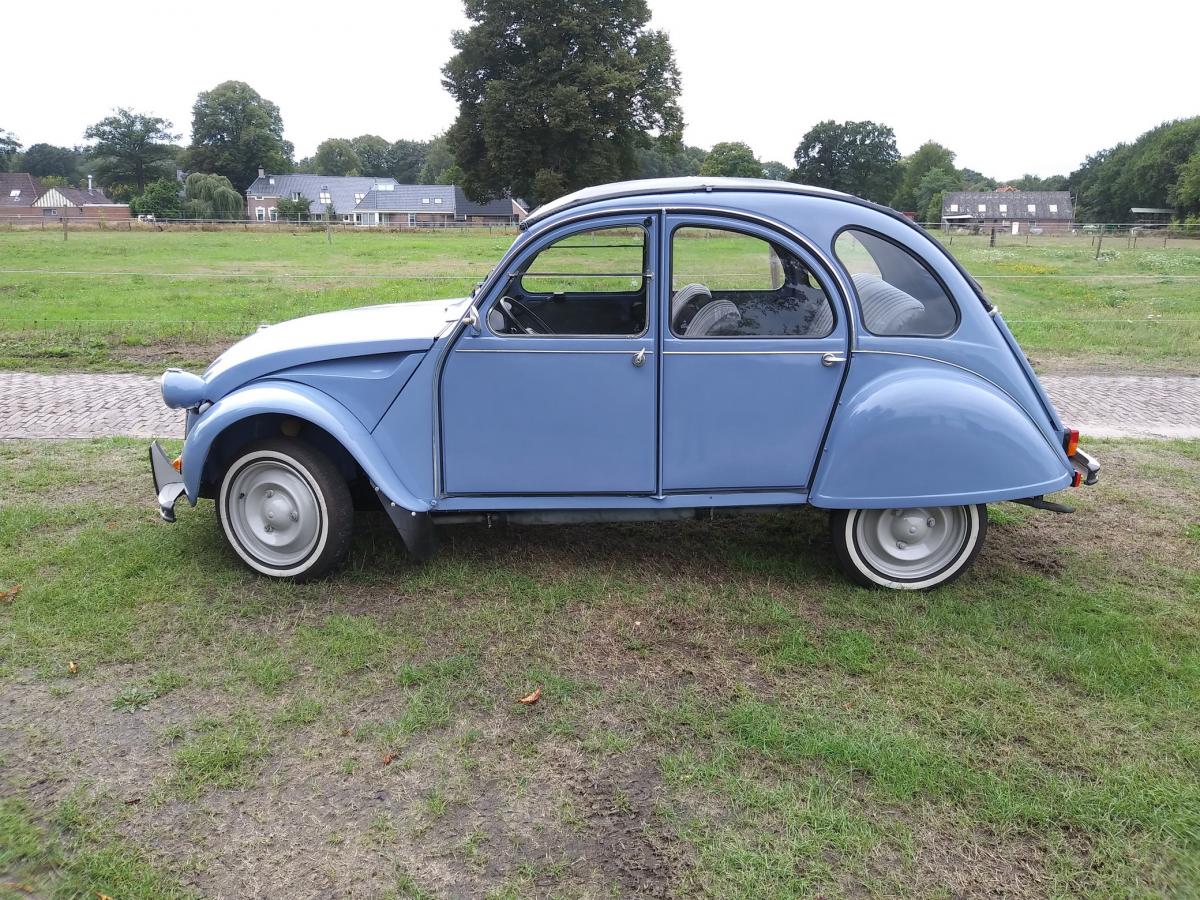
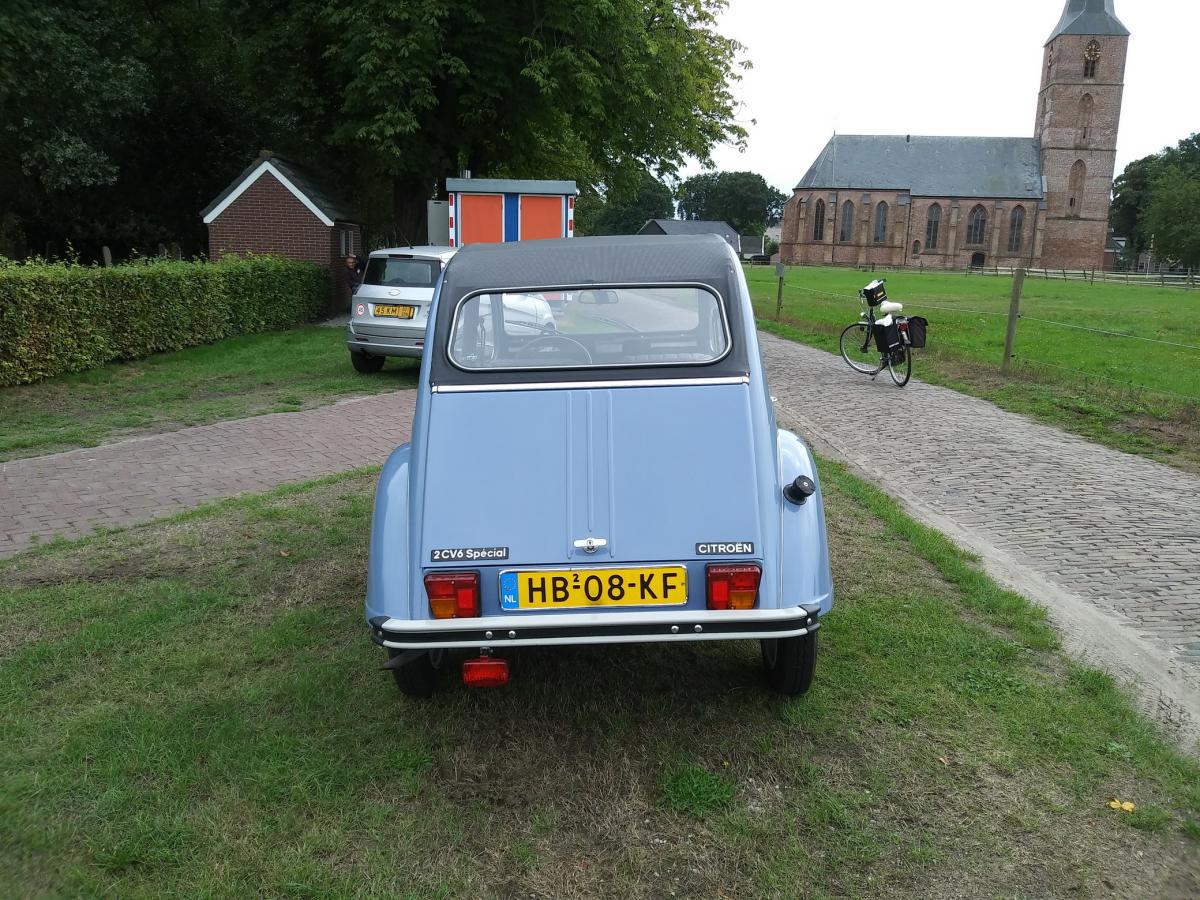
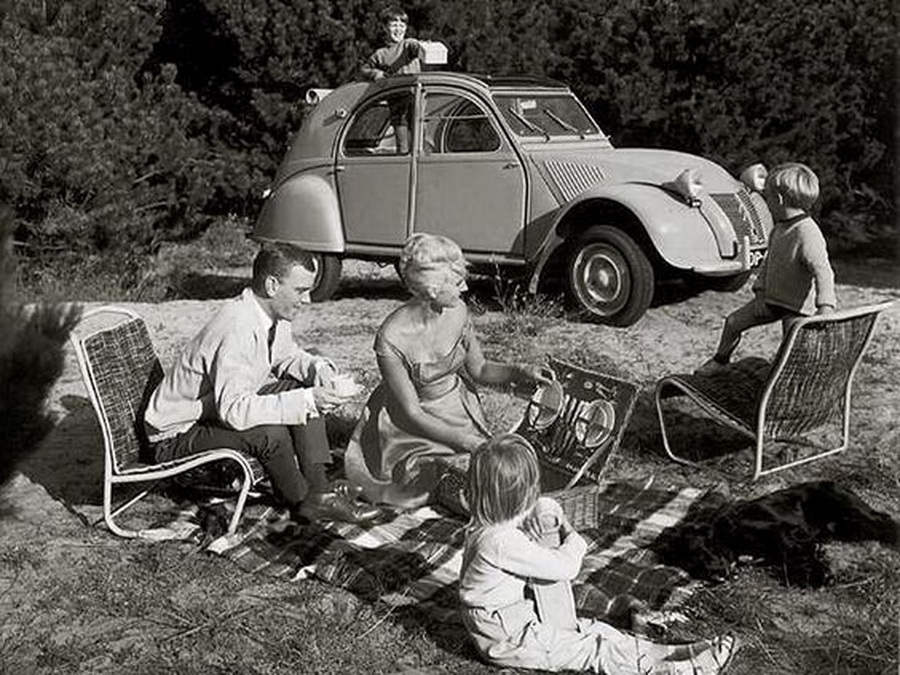
-914 AEC Articulated Lorry (1965-70)
-163 Bristol 450 Sports Coupé (1956-60)
-163 Bristol 450 Sports Coupé (1956-60)
-914 AEC Articulated Lorry (1965-70)
DTCAwebsite upgrade 2023
DTCAwebsite upgrade 2023
DTCAwebsite upgrade 2023
DTCAwebsite upgrade 2023
DTCAwebsite upgrade 2023
DTCAwebsite upgrade 2023
-508 DAF
--14c and 401Coventry Climax Fork Lift Truck (1949-64)
FRENCH DINKY TALBOT LAGO
-Boxes General Discussions including end flaps, both British and French
--14c and 401Coventry Climax Fork Lift Truck (1949-64)
--14c and 401Coventry Climax Fork Lift Truck (1949-64)
-508 DAF
DTCAwebsite upgrade 2023
DTCAwebsite upgrade 2023
DTCAwebsite upgrade 2023
DTCAwebsite upgrade 2023
DTCAwebsite upgrade 2023
-508 DAF
-508 DAF
-508 DAF
New arrivals
New arrivals
DTCAwebsite upgrade 2023
DTCAwebsite upgrade 2023
ORIGINAL MECCANO DINKY TOYS FACTORY BOX ART 175 HILLMAN MINX SALOON + DRAWING
--29c and 290 Double Decker Bus (1938-63)
DTCAwebsite upgrade 2023
DTCAwebsite upgrade 2023
DTCAwebsite upgrade 2023
DTCAwebsite upgrade 2023